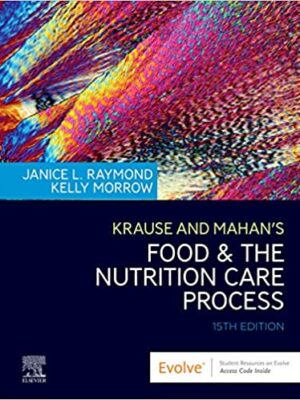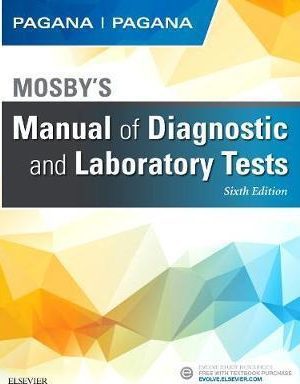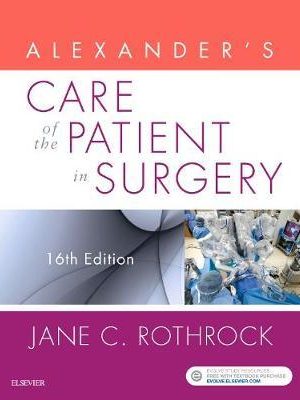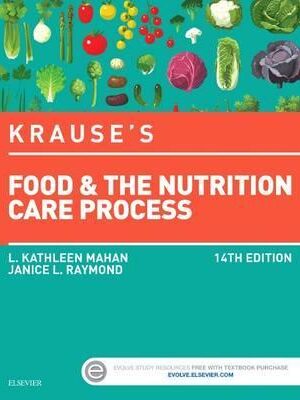Krause’s Food & the Nutrition Care Process 14th Edition
Krause’s Food & the Nutrition Care Process 14th Edition (Krause’s Food & Nutrition Therapy):
A trusted classic for over 50 years, Krause’s Food and the Nutrition Care Process, 14th Edition presents the most cutting-edge and up-to-date dietetics content available in this ever-changing field. Nicknamed the “nutrition bible”, students and practitioners alike turn to its current, comprehensive content, engaging pedagogy and design, and logical presentation of information. This new edition includes the 2015 Dietary Guidelines for Americans, more visuals, and highlighted Clinical Case Studies, Clinical Insights, and Clinical Applications boxes that help translate scientific knowledge into practical patient care. Written by nearly 50 nationally recognized writers, researchers, and practitioners, it covers nutrition assessment and intervention, the nutritional needs of individuals in different stages of the life cycle, nutrition for health and fitness, and medical nutrition therapy.
- Authored by clinical specialists, ensuring in-depth coverage with many practical and evidence-based recommendations.
- Sample Nutrition Diagnosis boxes present a problem, its etiology, and its signs and symptoms before concluding with a sample nutrition diagnosis, providing both students and practitioners with real-life scenarios they may encounter in practice.
- UNIQUE! Pathophysiology algorithms present the cause, pathophysiology, and medical nutrition management for a variety of disorders and conditions to help you provide optimal nutritional care.
- Chapters on nutrition in each of the life cycle phases, include:
-
- Nutrition in Pregnancy and Lactation
- Nutrition in Infancy
- Nutrition in Childhood
- Nutrition in Adolescence
- Nutrition in the Adult Years
- Nutrition in Aging
- Focus On boxes provide thought-provoking information on key concepts for well-rounded study and further discussion within the classroom.
- New Directions boxes point you toward additional research on emerging areas in nutrition therapy.
- Clinical Insight boxes expand on clinical information, highlight areas that may go unnoticed, and contain clinical resources for students and practitioners.
- Chapters on the nutritional care of the low-birth-weight and premature infant feature information on how to support their health, growth, and development.
- Useful websites direct you to online resources that relate to chapter topics.
- Key terms are defined at the beginning of each chapter and bolded within the text where they are discussed in more detail.
- NEW! The most up-to-date content throughout, including the 2015 Dietary Guidelines for Americans.
- NEW! Worksheets on how to calculate parenteral and enteral nutrition needs added to Chapter 14: Food and Nutrient Delivery: Nutrition Support Methods.
- NEW! Clinical Case Studies and Clinical Applications boxes help translate academic knowledge into practical patient care.
- NEW! The latest recommendations from the National Institutes of Health are discussed in Chapter 33: MNT for Cardiovascular Disease.
- NEW! Standards of Care recommendations incorporated throughout the book.
- NEW! Inflammation and the Pathophysiology of Chronic Disease chapter cross-references to diseases with inflammation in the MNT chapters.
- NEW! More visuals added to Chapter 6, Clinical: Water, Electrolytes, and Acid-Base Balance, to help convey key concepts.
- NEW! Nutrition and the Affordable Care Act, Human Milk Banking, and Vending Machine Labeling Law boxes highlight the latest information on these hot topics.
- NEW! The Anti-inflammatory Diet appendix details the disease-fighting potential of anti-inflammatory foods.
- EXPANDED! MNT for Psychiatric Conditions chapter includes the most up-to-date material on Parkinson’s disease and Alzheimer’s disease.
Additional ISBNs:
∗ eText ISBN: 0323340806, 978-0323340809, 9780323340809
- See additional information on the Amazon.
More Details
Krause’s Food & the Nutrition Care Process 14th Edition:
Cover image
Title page
Table of Contents
Inside front cover
Copyright
Dedication
Contributors
Reviewers
Foreword
Preface
Acknowledgments
1. Nutrition Assessment
Introduction
1. Intake: Digestion, absorption, transport, and excretion of nutrients
The gastrointestinal tract
Brief overview of digestive and absorptive processes
The small intestine: Primary site of nutrient absorption
The large intestine
Useful websites
References
2. Intake: Energy
Energy requirements
Components of energy expenditure
Estimating energy requirements
Calculating food energy
Useful websites/apps
References
3. Inflammation and the pathophysiology of chronic disease
Epidemic of chronic disease
Concepts of chronic disease pathophysiology
Inflammation: Common denominator of chronic disease
Nutrient modulators of inflammation
Reducing inflammation in the body
Prolonged inflammation expression specific to major chronic diseases
Summary
Useful websites
References
4. Intake: Analysis of the diet
Nutrition screening
Nutrition assessment
Analysis of dietary intake data
Useful websites
References
5. Clinical: Nutritional genomics
The human genome project and the “OMIC” disciplines
Genotype and nutrition assessment
Genetic fundamentals
Genetics and nutrition therapy
Ethical, legal, and social implications
Summary
Useful websites
References
6. Clinical: Water, electrolytes, and acid-base balance
Body water
Electrolytes
Acid-base balance
Acid-base disorders
Useful websites, tools/calculators, and apps
References
7. Clinical: Biochemical, physical, and functional assessment
Biochemical assessment of nutrition status
Nutrition interpretation of routine medical laboratory tests
Assessment of hydration status
Assessment for nutritional anemias
Fat-soluble vitamins
Water-soluble vitamins and trace minerals
Chronic disease risk assessment
Physical assessments
Nutrition-focused physical assessment
Useful websites
References
8. Clinical: Food-drug interactions
Pharmacologic aspects of food-drug interactions
Risk factors for food-drug interactions
Effects of food on drug therapy
Medication and enteral nutrition interactions
Effects of drugs on food and nutrition
Modification of drug action by food and nutrients
Effects of drugs on nutrition status
Excipients and food-drug interactions
Medical nutrition therapy
Useful websites
References
9. Behavioral-environmental: The individual in the community
Social determinants of health
Nutrition practice in the community
Needs assessment for community-based nutrition services
National nutrition surveys
National nutrition guidelines and goals
Food assistance and nutrition programs
Foodborne illness
Food and water safety
Disaster planning
Healthy food and water systems and sustainability
Summary: A work in progress
Useful websites
References
2. Nutrition Diagnosis and Intervention
Introduction
10. Overview of nutrition diagnosis and intervention
The nutrition care process
Documentation in the nutrition care record
Influences on nutrition and health care
Nutrition interventions
Nutrition for the terminally ill or hospice patient
Useful websites
References
11. Food and nutrient delivery: Diet guidelines, nutrient standards, and cultural competence
Determining nutrient needs
Worldwide guidelines
Nutritional status of Americans
National guidelines for diet planning
Food and nutrient labeling
Dietary patterns and counseling tips
Cultural aspects of dietary planning
Useful websites
References
12. Food and nutrient delivery: Complementary and integrative medicine and dietary supplementation
Complementary and integrative medicine
Use of complementary and integrative therapies
Dietary supplementation
Dietary supplement regulation
Assessment of dietary supplement use in patients
Useful websites
References
13. Food and nutrient delivery: Nutrition support 1
Rationale and criteria for appropriate nutrition support
Enteral nutrition
Enteral nutrition access
Parenteral nutrition
Complications
Refeeding syndrome
Transitional feeding
Nutrition support in long-term and home care
Useful websites
References
14. Education and counseling: Behavioral change
Behavior change
Models for behavior change
Models for counseling strategies
Models for educational program development
Skills and attributes of the nutrition educator or counselor
Assessment results: Choosing focus areas
Counseling approaches after the assessment
Unsure-about-change counseling sessions
Resistance behaviors and strategies to modify them
Ready-to-change counseling sessions
Evaluation of effectiveness
Summary
Useful websites
References
3. Nutrition in the Life Cycle
Introduction
15. Nutrition for reproductive health and lactation
Preconception and fertility
Conception
Pregnancy
Postpartum period = preconceptual period
Lactation
Useful websites
References
16. Nutrition in infancy
Physiologic development
Nutrient requirements
Milk
Food
Feeding
Useful websites
References
17. Nutrition in childhood
Growth and development
Nutrient requirements
Providing an adequate diet
Nutritional concerns
Preventing chronic disease
Useful websites
References
18. Nutrition in adolescence
Growth and development
Nutrient requirements
Food habits and eating behaviors
Nutrition screening, assessment, and counseling
Special concerns
Useful websites
References
19. Nutrition in the adult years
Setting the stage: Nutrition in the adult years
Setting the stage: Messages
Information sources
Lifestyle health risk factors
Health disparities and access to care
Interventions, nutrition, and prevention
Food trends and patterns
Nutritional supplementation
Functional foods
Healthy food and water systems and sustainability
Adult health next steps
Useful websites
References
20. Nutrition in aging
The older population
Gerontology + geriatrics = the spectrum of aging
Nutrition in health promotion and disease prevention
Theories on aging
Physiologic changes
Quality of life
Nutrition screening and assessment
Nutrition needs
Medicare benefits
Nutrition support services
Community and residential facilities for older adults
Useful websites
References
4. Nutrition for Health and Fitness
Introduction
21. Nutrition in weight management
Body weight components
Regulation of body weight
Weight imbalance: Overweight and obesity
Management of obesity in adults
Common problems in obesity treatment
Weight management in children and adolescents
Weight imbalance: Excessive leanness or unintentional weight loss
Useful websites
References
22. Nutrition in eating disorders
Clinical characteristics and medical complications
Treatment approach
Psychologic management
Nutrition management
Medical nutrition therapy and counseling
Useful websites
References
23. Nutrition in exercise and sports performance
An integrative approach to working with athletes
Bioenergetics of physical activity
Fuels for contracting muscles
Nutritional requirements of exercise
Weight management
Weight management and aesthetics
Macronutrients
Carbohydrate
Protein
Fat
Fluid
Other considerations
Vitamins and minerals
Minerals
Ergogenic aids
Ergogenic aids for high intensity exercise
Herbs
Performance enhancement substances and drugs (PES/PED): Doping in sport
Useful websites
References
24. Nutrition and bone health
Bone structure and bone physiology
Osteopenia and osteoporosis
Diagnosis and monitoring
Nutrition and bone
Prevention of osteoporosis and fractures
Treatment of osteoporosis
Useful websites
References
25. Nutrition for oral and dental health
Nutrition for tooth development
Dental caries
Early childhood caries
Caries prevention
Tooth loss and dentures
Other oral disorders
Periodontal disease
Oral manifestations of systemic disease
Useful websites
References
5. Medical Nutrition Therapy
Introduction
26. Medical nutrition therapy for adverse reactions to food: Allergies and intolerances
Definitions
Etiology
Pathophysiology
Food intolerances
Assessment
Medical nutrition therapy
Emerging therapies
Preventing food allergy
Useful websites and apps
References
27. Medical nutrition therapy for upper gastrointestinal tract disorders
Assessment parameters
The esophagus
The stomach
Gastroparesis
Useful websites
References
28. Medical nutrition therapy for lower gastrointestinal tract disorders
Common intestinal problems
Diseases of the small intestine
Intestinal brush-border enzyme deficiencies
Inflammatory bowel diseases
Nutritional consequences of intestinal surgery
Useful websites
References
29. Medical nutrition therapy for hepatobiliary and pancreatic disorders
Physiology and functions of the liver
Diseases of the liver
Complications of ESLD: Cause and nutrition treatment
Nutrition issues related to end-stage liver disease
Nutrient requirements for cirrhosis
Herbal supplements and liver disease
Liver resection and transplantation
Physiology and functions of the gallbladder
Diseases of the gallbladder
Complementary and integrative medicine
Physiology and functions of the exocrine pancreas
Diseases of the exocrine pancreas
Complementary and integrative medicine
Pancreatic surgery
Useful websites
References
30. Medical nutrition therapy for diabetes mellitus and hypoglycemia of nondiabetic origin
Incidence and prevalence
Categories of glucose intolerance
Screening and diagnostic criteria
Management of prediabetes
Management of diabetes
Implementing the nutrition care process
Acute complications
Long-term complications
Hypoglycemia of nondiabetic origin
Useful websites
References
31. Medical nutrition therapy for thyroid, adrenal, and other endocrine disorders
Thyroid physiology
Assessment in thyroid disorders
Hypothyroidism
Polycystic ovary syndrome
Hyperthyroidism
Managing imbalances of the hypothalamus-pituitary-thyroid axis
Adrenal disorders
Useful websites
References
32. Medical nutrition therapy for anemia
Iron-related blood disorders
Iron overload
Megaloblastic anemias
Other nutritional anemias
Nonnutritional anemias
Useful websites
References
33. Medical nutrition therapy for cardiovascular disease
Atherosclerosis and coronary heart disease
Genetic hyperlipidemias
Hypertension
Heart failure
Cardiac transplantation
Useful websites
References
34. Medical nutrition therapy for pulmonary disease
The pulmonary system
Chronic pulmonary disease
Asthma
Chronic obstructive pulmonary disease
Tuberculosis
Lung cancer
Obesity hypoventilation syndrome
Chylothorax
Acute respiratory distress syndrome
Pneumonia
Bronchopulmonary dysplasia
Useful websites
References
35. Medical nutrition therapy for renal disorders
Physiology and function of the kidneys
Renal diseases
Acute kidney injury (acute renal failure)
Diseases of the tubules and interstitium
Glomerular diseases
Chronic kidney disease
End-stage renal disease
Useful websites
References
36. Medical nutrition therapy for cancer prevention, treatment, and survivorship
Pathophysiology
Nutrition and carcinogenesis
Chemoprevention
Medical diagnosis and staging of cancer
Medical treatment
Medical nutrition therapy
Nutritional impact of cancer treatments
Nutrition monitoring and evaluation
Pediatric cancer
Nutrition recommendations for cancer survivors
Integrative oncology
Useful websites and resources
References
37. Medical nutrition therapy for HIV and AIDS
Epidemiology and trends
Pathophysiology and classification
Medical management
Medical nutrition therapy
Special considerations
HIV in women
HIV in children
Complementary and integrative therapies
Useful websites
References
38. Medical nutrition therapy in critical care
Metabolic response to stress
Hormonal and cell-mediated response
Starvation versus stress
Systemic inflammatory response syndrome (SIRS) and multiple organ dysfunction syndrome (MODS)
Malnutrition: The etiology-based definition
Trauma and the open abdomen
Major burns
Surgery
Useful websites
References
39. Medical nutrition therapy for rheumatic disease
Etiology
Pathophysiology and inflammation
Medical diagnosis and treatment
Pharmacotherapy
Antiinflammatory diet
Complementary or integrative therapies
Microbiota and arthritis
Osteoarthritis
Rheumatoid arthritis
Sj?gren syndrome (SS)
Temporomandibular disorders
Gout
Scleroderma
Systemic lupus erythematosus
Spondylarthritides
Useful websites
References
40. Medical nutrition therapy for neurologic disorders
The central nervous system
Issues complicating nutrition therapy
Dysphagia
Neurologic diseases of nutritional origin
Neurologic disorders from trauma
Head trauma or neurotrauma
Spine trauma and spinal cord injury
Neurologic diseases
Useful websites
References
41. MNT in psychiatric and cognitive disorders
The enteric nervous system (ENS)
Blood glucose regulation
Food allergies and sensitivities
The role of nutrients in mental function
Addiction and substance abuse
Anxiety
Bipolar disorder
Dementia and Alzheimer’s disease (AD)
Depression
Fatigue, chronic fatigue syndrome (CFS), and fibromyalgia syndrome (FMS)
Schizophrenia
References
6. Pediatric Specialties
Introduction
42. Medical nutrition therapy for low-birth-weight infants
Infant mortality and statistics
Physiologic development
Nutrition requirements: Parenteral feeding
Transition from parenteral to enteral feeding
Nutrition requirements: Enteral feeding
Feeding methods
Selection of enteral feeding
Nutrition assessment and growth
Discharge care
Neurodevelopmental outcome
Useful websites
References
43. Medical nutrition therapy for genetic metabolic disorders
Newborn screening
Disorders of amino acid metabolism
Phenylketonuria
Disorders of organic acid metabolism
Disorders of urea cycle metabolism
Disorders of carbohydrate metabolism
Disorders of fatty acid oxidation
Role of the nutritionist in genetic metabolic disorders
Useful websites
References
44. Medical nutrition therapy for intellectual and developmental disabilities
Medical nutrition therapy
Chromosomal aberrations
Neurologic disorders
Fetal alcohol syndrome
Controversial nutrition therapy
Community resources
Useful websites
References
APPENDICES
INDEX
Inside back cover





























 Dentistry
Dentistry
Reviews
There are no reviews yet.